March 2013 Retail Sales decreased, by -0.4%. This is the lowest monthly change in retail sales since June 2012. Gasoline sales declined the most, -2.2% for the month. If one removes gasoline sales from retail sales, overall the decrease from February would have been -0.2%, or half of the monthly decline. Auto sales decreased -0.6% and minus all autos & parts but including gas sales, retail sales dropped -0.4% from last month. This report should amplify Wall Street's worries people are so tapped out they have stopped spending and ruin their stock market run up. Retail sales are reported by dollars, not by volume with price changes removed.

For the three month moving average, from January to March (Q1) in comparison to October to December (Q4), retail sales have increased 1.0%. The retail sales three month moving average in comparison to a year ago is up 3.7%. That's going to be upsetting to Wall Street in terms of consumer spending implications.
Retail trade sales are retail sales minus food and beverage services. Retail trade sales includes gas, and is down -0.6% for the month, up 2.6% from last year.
Total retail sales are $418.3 billion for March. Below are the retail sales categories monthly percentage changes. These numbers are seasonally adjusted. General Merchandise includes super centers, Costco and so on. Online shopping making increasing gains, increasingly important in overall retail sales. Nonstore retail sales have increased 14.5% from last year. Autos sales have increased 8.2% from a year ago.
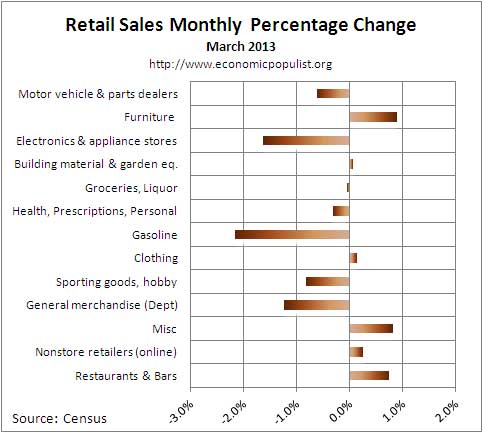
Gasoline station sales have increased 1.1% from one year ago. Sporting goods, hobbies, books & music sales have increased 6.5% from last year. Autos & parts sales overall have increased 7.1% from last year. The ones that are hurting are Departments stores. Their retail sales are down -4.9% from March 2012 with general merchandise stores overall are down -3.7% from a year ago. Building materials, garden sales, which are large by volume, have increased 2.6% from a year ago. Grocery stores have increased sales by 2.8% from this time last year. Below are the March retail sales categories by dollar amounts. As we can see, autos still rule when it comes to retail sales. We also see that electronics is much smaller by total dollars.
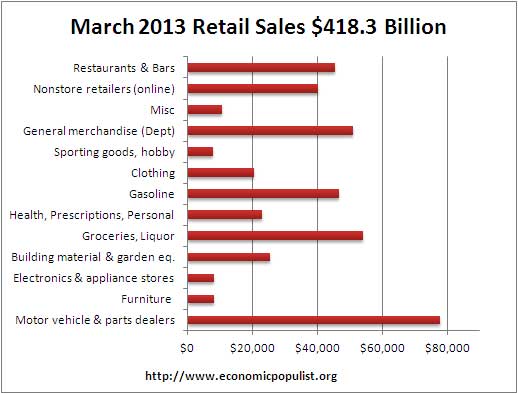
For reference sake, graphed below are weekly regular gasoline prices, so one can see what happened to gas prices in March. Gas prices actual declined -2.7% from February to March. If one takes the last price of March vs. the April 1st price, gas has dropped -3.7% for March, on the outside. That said, considering February's gas price increase run up of 12.7%, we cannot blame March's poor retail sales figures on the price of gas this time. Instead it looks like people just filled up the tank less.

The below pie chart breaks down the monthly seasonally adjusted retail sales by category as a percentage of total March sales by dollar amounts. One can see how dependent monthly retail sales are on auto sales by this pie chart. We also see non-traditional retailers making strong grounds on traditional general merchandise stores.
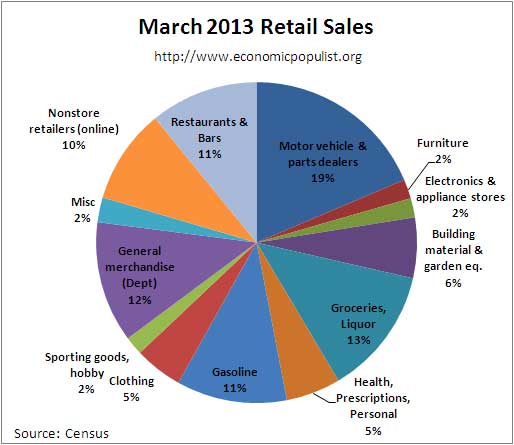
Retail sales correlates to personal consumption, which in turn is about 70% of GDP growth. Yet GDP has inflation removed from it's numbers. This is why Wall Street jumps on these retail sales figures. Below is the graph of retail sales in real dollars, or adjusted for inflation, so one gets a sense of volume versus price increases. Below is the annualized monthly percentage change in real retail sales, monthly, up to February 2013.
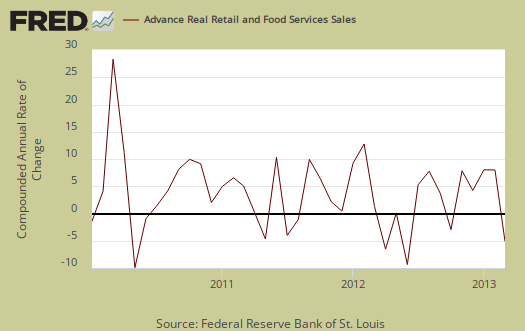
To obtain real values, retail sales are deflated using CPI. Below are the real retail sales quarterly annualized percent change. The graph displays up to Q4 2012.
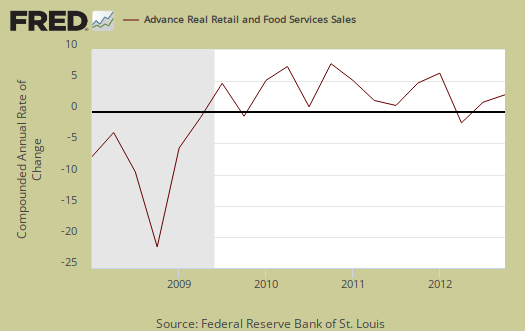
Below is a graph of real PCE against real retail sales, quarterly. See how closely the two track each other? PCE almost looks like a low pass filter, an averaging, removal of "spikes", of real retail sales. Here are our overviews for PCE. Here is our overview of Q4 GDP.

Retail sales are not adjusted for price increases, not reported in real dollars. Real economic growth adjusts for inflation. Retail sales has variance, margins of error, and is often revised as more raw data comes into the U.S. Department of Commerce (Census division). For example, this report has an error margin of ±0.5%. Data is reported via surveys, and is net revenues of retail stores, outlets. Online retail net revenues are asked in a separate survey of large retail companies (big box marts). This is also the advanced report. To keep the monthly nominal percentage changes in perspective, below is the graph of monthly percentage changes of retail sales since 2008.
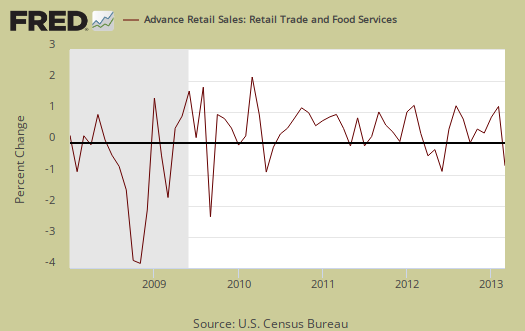
Seasonal adjustments are aggregate and based on events like holidays associated with shopping, i.e. the Christmas rush. Advance reports almost always are revised the next month as more raw sales data is collected by the Census. In other words, do not get married to these figures, they will surely be revised. Here is our retail sales topic category.
Here is last month's overivew of retail sales, unrevised.

i would say more...
you said "it looks like people just filled up the tank less"
gas stations sales dropped 2.2%, while prices were 2.7% lower, meaning volume gas sales rose, right?
rjs
why I said don't blame gas
That's true but if you take the final price and not the average price over March. So sales are through the month and by April 1st, yes prices were 2.7% lower, but sales were throughout the month. So depending on how you calculate the percentage drop in gas it shows sales by volume didn't increase. For example, if I take the average monthly gas price, on a weekly basis which is itself an average from 900 gas stations, then take the percentage change from February, we get a 1.1% increase in prices. This isn't the same as February where gas prices on average skyrocketed, driving February retail sales.
I guess I should have explained the title more than I did.